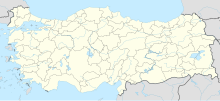Adramyttion
Coordinates: 39 ° 29 ′ 52 ″ N , 26 ° 56 ′ 15 ″ E
Adramyttion (Ἀδραμύττιον) was an ancient city in northwest Asia Minor , the predecessor settlement of today's Edremit in the province of Balıkesir .
In the 19th century Adramyttion was located under the village of Ören on Cape Ören (formerly Cape Karataş) opposite Lesvos on the east bank of the Gulf of Adramyttion (Edremit Körfezi) . The information on early history, especially on possible predecessor settlements, is contradictory. It is controversial, for example, whether the foundation went back to Thracian or Lydian initiative. According to Stephanos Byzantios , Adramys , the brother of the Lydian king Kroisos , was the founder of the city. The city owes its importance to its exposed location, which allowed it to control both important sea and land routes, and the safe harbor. For centuries Adramyttion was important as a trading center for the products of the plains of Thebe and the forests of the Ida .
It can be assumed that the city played an important role in the Lydian Empire. So before his accession to the throne, Kroisos was the city's archon . 422 BC The city was Hellenized by the admission of exiles from Delos , who had been driven out by the Athenians , with the permission of the Satrap of Daskyleion . That is why Adramyttion sometimes appears in the sources as the “Greek city”. At a time that cannot be exactly reconstructed (according to Strabo ) Athenians also settled the city. 411 BC A massacre was committed among the Greek population - especially the upper class - of the city under the leadership of Arsakes , a subordinate of the satrap Tissaphernes . Nevertheless, the Greek influence could not be pushed back. Adramyttion's constitution is one of those that Aristotle included in his collection.
During the satrap revolt Adramyttion was the refuge of Ariobarzanes , which is why the city was built in 366 BC. Was besieged by Autophradates . 362/361 BC BC coins with the image of the rebel Orontes I were minted in the city . Even in the Hellenistic period, Adramyttion was often the scene of armed conflicts due to its strategic location, for example in 302 BC. By Prepelaos (conquest), 201 BC. By Philip V (pillage) and 190 BC. By Antiochus III. The city was saved from the latter by a Roman fleet. The Romans then added the city to the Empire of the Attalids of Pergamon . Under the Attalids, the city was developed into an administrative center for a dioíkēsis . It was able to benefit greatly from the increase in territory due to the addition of Thebe, Lyrnessos and Iolla . Initially, the city supported Mithridates VI. and was a site of the Italian massacre , which resulted in a Roman criminal court. 84 BC The inhabitants rose successfully against Mithridates. When the Romans conquered and reorganized the area, Adramyttion became the capital of a conventus , 75 BC. Finally, the seat of the portorium Asiae .
The independent coinage of the city ended during the reign of Emperor Gallienus . From 431 and especially in Byzantine times, the city was the seat of a bishopric. The abandonment of the port of Karach due to silting up, which dates back to Trajan times, did not take place until around 1100. The name of the city lives on in the name of the successor settlement Edremit, 15 km away.
Adramyttion is the site of a Roman Senate resolution from 129 BC. BC, in which there was a dispute between Publicani and Pergamon. Shipyards and a rhetorician school were also known in Roman times. There is also evidence of a Jewish community.
literature
- Gustav Hirschfeld : Adramytteion . In: Paulys Realencyclopadie der classischen Antiquity Science (RE). Volume I, 1, Stuttgart 1893, Col. 404.
- Josef Stauber: The Bay of Adramytteion . 2 volumes:
- Volume 1: Topography (localization of ancient places, sites of antiquity) . Habelt, Bonn 1996 ( inscriptions of Greek cities from Asia Minor , 50), ISBN 3-7749-2749-9 .
- Volume 2: Inscriptions, literary testimonia, coins . Habelt, Bonn 1996 (inscriptions of Greek cities from Asia Minor, 51), ISBN 3-7749-2750-2 .



